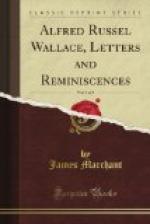Again, writing about the same period, he adds: “I begin to feel rather dissatisfied with a mere local collection; little is to be learnt by it. I should like to take some one family to study thoroughly, principally with a view to the theory of the origin of species. By that means I am strongly of opinion that some definite results might be arrived at.” And he further alludes to “my favourite subject—the variations, arrangements, distribution, etc., of species."[17]
It is evident that in Bates Wallace found his first real friend and companion in matters scientific; for in another letter he says: “I quite envy you, who have friends near you attracted to the same pursuits. I know not a single person in this little town who studies any one branch of natural history, so that I am quite alone in this respect.” In fact, except for a little friendly help now and then, as in the case of Mr. Hayward lending him a copy of Loudon’s Encyclopedia of Plants, he had always pondered over his nature studies without any assistance up to the time of his meeting Bates at Leicester.
From the date of the above letter (1847) on to the early part of 1855—nearly eight years later—no reference is found either in his Life or correspondence to the one absorbing idea towards which all his reflective powers were being directed. Then, during a quiet time at Sarawak, the accumulation of thought and observation found expression in an essay entitled “The Law which has regulated the Introduction of Species,” which appeared in the Annals and Magazine of Natural History in the following September (1855).
From November, 1854, the year of his arrival in the East, until January or February, 1856, Sarawak was the centre from which Wallace made his explorations inland, including some adventurous excursions on the Sadong River. During the wet season—or spring—of 1855, while living in a small house at the foot of the Santubong Mountains (with one Malay boy who acted as cook and general companion), he tells us how he occupied his time in looking over his books and pondering “over the problem which was rarely absent from [his] thoughts.” In addition to the knowledge he had acquired from reading such books as those by Swainson and Humboldt, also Lucien Bonaparte’s “Conspectus,” and several catalogues of insects and reptiles in the British Museum “giving a mass of facts” as to the distribution of animals over the whole world, and having by his own efforts accumulated a vast store of information and facts direct from nature while in South America and since coming out East, he arrived at the conclusion that this “mass of facts” had never been properly utilised as an indication of the way in which species had come into existence. Having no fellow-traveller to whom he could confide these conclusions, he was almost driven to put his thoughts and ideas on paper—weighing each argument with studious care and open-eyed consideration as to its bearing on the whole theory. As the “result seemed to be of some importance,” it was sent, as already mentioned, to the Annals and Magazine of Natural History as one of the leading scientific journals in England.




